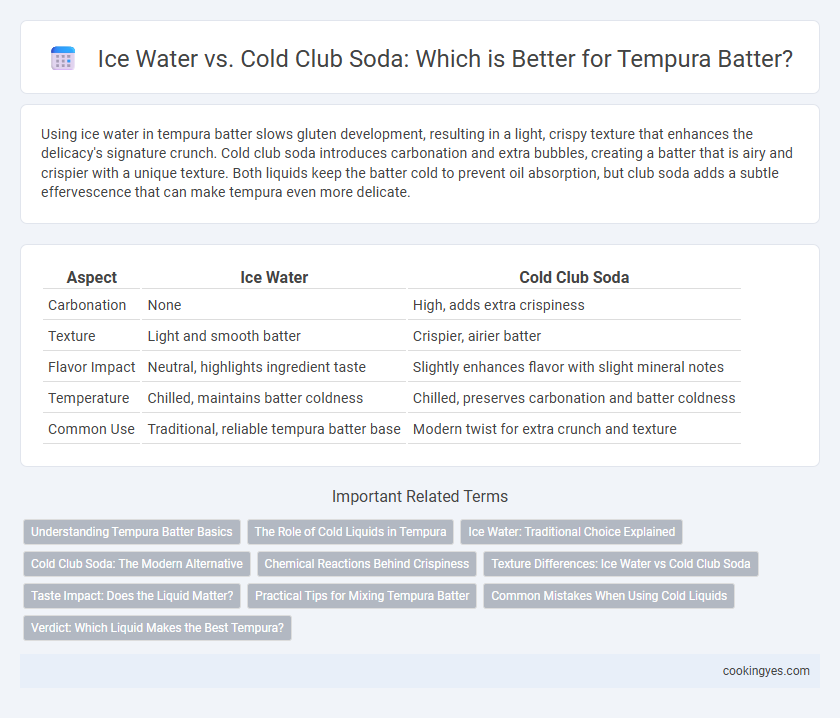Using ice water in tempura batter slows gluten development, resulting in a light, crispy texture that enhances the delicacy's signature crunch. Cold club soda introduces carbonation and extra bubbles, creating a batter that is airy and crispier with a unique texture. Both liquids keep the batter cold to prevent oil absorption, but club soda adds a subtle effervescence that can make tempura even more delicate.
Table of Comparison
| Aspect | Ice Water | Cold Club Soda |
|---|---|---|
| Carbonation | None | High, adds extra crispiness |
| Texture | Light and smooth batter | Crispier, airier batter |
| Flavor Impact | Neutral, highlights ingredient taste | Slightly enhances flavor with slight mineral notes |
| Temperature | Chilled, maintains batter coldness | Chilled, preserves carbonation and batter coldness |
| Common Use | Traditional, reliable tempura batter base | Modern twist for extra crunch and texture |
Understanding Tempura Batter Basics
Ice water keeps tempura batter cold, which slows gluten development for a lighter, crispier texture. Cold club soda introduces carbonation that creates airy bubbles, enhancing the batter's crispiness without heaviness. Both choices maintain low temperatures essential for optimal tempura batter consistency and delicate frying results.
The Role of Cold Liquids in Tempura
Cold liquids like ice water and cold club soda are essential in tempura batter to inhibit gluten development, resulting in a lighter, crispier texture. Ice water provides a neutral temperature that keeps the batter cool without adding carbonation, preserving the traditional crispness. Cold club soda introduces carbonation bubbles that create extra aeration, enhancing the tempura's delicacy and crunchiness while maintaining the necessary low temperature for optimal frying results.
Ice Water: Traditional Choice Explained
Ice water is the traditional choice for tempura batter due to its ability to slow gluten formation, resulting in a lighter, crispier texture. The cold temperature prevents the flour from absorbing too much moisture, which helps maintain the batter's delicate, airy quality. Using ice water ensures the characteristic tempura crunch while preserving the subtle flavors of seafood and vegetables.
Cold Club Soda: The Modern Alternative
Cold club soda enhances tempura batter by introducing fine carbonation that creates an exceptionally light, crispy texture unmatched by ice water. The carbonation in club soda aerates the batter, resulting in a delicate, airy coating that quickly absorbs heat for faster frying and less oil absorption. This modern alternative not only improves texture but also offers a subtle mineral taste that complements the tempura's natural flavors.
Chemical Reactions Behind Crispiness
Cold club soda introduces carbon dioxide bubbles that create tiny air pockets in tempura batter, enhancing its light, crispy texture through physical aeration. Ice water keeps the batter cold, slowing gluten formation and enzyme activity, which helps maintain tenderness and prevents toughness. The combination of cold temperature and carbonation optimizes the batter's chemical reactions, resulting in the ideal crispiness and delicate crunch characteristic of perfect tempura.
Texture Differences: Ice Water vs Cold Club Soda
Using ice water in tempura batter results in a light, crisp texture due to its cold temperature slowing gluten formation. Cold club soda introduces carbonation, creating tiny bubbles that produce an airy, flaky crust with enhanced crispness. The choice between ice water and cold club soda directly impacts the tempura's delicate texture and mouthfeel, with club soda often yielding a more pronounced crunch.
Taste Impact: Does the Liquid Matter?
The choice between ice water and cold club soda in tempura batter significantly influences the taste and texture, as club soda introduces carbonation that creates a lighter, crispier crust with a subtle effervescence. Ice water results in a smoother batter that yields a tender, slightly denser coating, allowing the natural flavor of the ingredients to come forward without added fizz. The effervescent quality of club soda enhances the overall flavor perception by creating a delicate crunch, making the final dish more dynamic in both taste and mouthfeel.
Practical Tips for Mixing Tempura Batter
Using ice water in tempura batter helps maintain a cold temperature, preventing gluten formation and resulting in a lighter, crispier texture. Cold club soda adds carbonation, creating extra bubbles that enhance the batter's fluffiness and crunch. For best results, mix the batter gently to preserve the bubbles and avoid overworking it, ensuring a delicate and airy coating.
Common Mistakes When Using Cold Liquids
Using ice water or cold club soda in tempura batter can cause common mistakes such as overmixing, which leads to gluten development and a dense, heavy texture instead of light crispiness. Too cold liquids inhibit the batter from properly adhering to ingredients, resulting in uneven coating and oil absorption. Maintaining an optimal cold temperature without excessive chill ensures a delicate, airy tempura crust with minimal greasiness.
Verdict: Which Liquid Makes the Best Tempura?
Ice water provides a neutral temperature and consistency that helps create a light, crisp tempura batter by preventing gluten formation. Cold club soda's carbonation introduces fine bubbles that enhance the batter's texture, making it airier and crispier when fried. For the best tempura, many chefs prefer cold club soda due to its ability to produce a delicate, crunchy coating with improved mouthfeel.
Ice Water vs Cold Club Soda for Tempura Batter Infographic

 cookingyes.com
cookingyes.com